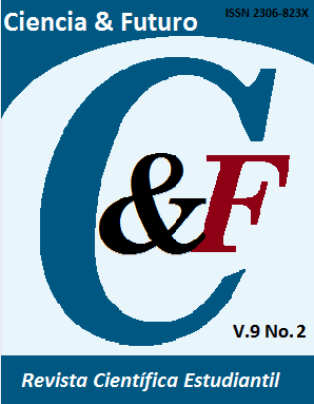Potentialities of clays as supplementary material for cement in Guamá municipality, Santiago de Cuba
Keywords:
Clays, supplementary cement material, kaolinite.Abstract
The potentialities of the clays from Guamá in Santiago de Cuba were evaluated for their use as supplementary materials for cement based on their chemical and mineralogical composition. Four clay deposits were selected (Pinar de las Canas, La Anita, Sabicú and Boca de Dos Ríos) with different geological genesis. The methodology used exposed a procedure, based on the chemical composition of the material (Al2O3> 18,0%, Al2O3 / SiO2> 0,3, PPI> 7,0%, CaO <3,0%, SO3<2,0%). The samples with the best potentialities were those with relatively high Al2O3 contents and mass loss in the dehydroxylation range of the clay minerals. It is concluded that clays from Sibacú deposit possess the greatest potential to be used as supplementary cement material; while those present in the other deposits studied are below the norm.Downloads
References
ALMENARES, R. 2017. Potencialidades de arcillas caoliníticas cubanas para la obtención de materiales cementicios suplementarios. Tesis doctoral. Universidad Central Martha Abreu de Las Villas.
ALMENARES, R. S.; ALUJAS-DÍAZ, A.; POLL, L.; BASSAS, P. R.; BETANCOURT, S.; MARTIRENA, J. F. & LEYVA, C. A. 2016. Evaluación de arcillas caoliníticas de Moa para la producción de cemento de base clínquer–arcilla calcinada–caliza (LC3). Minería y Geología 32(4): 63-76.
ALUJAS, A.; FERNÁNDEZ, R.; QUINTANA, R.; SCRIVENER, K. L. & MARTIRENA, F. 2015. Pozzolanic reactivity of low grade kaolinitic clays: Influence of calcination temperature and impact of calcination products on OPC hydration. Applied Clay Science 108: 94-101.
EMPRESA GEOMINERA ORIENTE. 1991. Informe Final de Exploración Orientativa y Detallada de arcilla para cerámica roja, Guamá, Santiago de Cuba. Santiago de Cuba.
HABERT, G.; DE LACAILLERIE, J. D. E. & ROUSSEL, N. 2011. An environmental evaluation of geopolymer based concrete production: reviewing current research trends. Journal of cleaner production 19(11): 1229-1238.
SABIR, B. B.; WILD, S. & BAI, J. 2001. Metakaolin and calcined clays as pozzolans for concrete: a review. Cement and concrete composites 23(6): 441-454.
SAMET, B.; MNIF, T. & CHAABOUNI, M. 2007. Use of a kaolinitic clay as a pozzolanic material for cements: Formulation of blended cement. Cement and Concrete Composites 29(10): 741-749.
SIVEIRO-FERNÁNDEZ, S. 2016. Evaluación de arcillas de bajo grado de caolinita del depósito El Yigre para la producción de cemento de bajo carbono. Tesis doctoral. Universidad Central "Martha Abreu" de Las Villas.
Published
How to Cite
Issue
Section
Copyright (c) 2019 Pedro L. Dunán-Ávila, Carlos A. Matos-Pérez, Luis A. Pérez-García, Santiago Cuba-Miranda, Carlos A. Leyva-Rodríguez

This work is licensed under a Creative Commons Attribution-NonCommercial 4.0 International License.
Esta obra está bajo una Licencia Creative Commons Reconocimiento-NoComercial 4.0 Internacional
La Revista Ciencia & Futuro es una revista de acceso abierto, todo el contenido está disponible gratuitamente sin cargo para el usuario o su institución. Los usuarios pueden leer, descargar, copiar, distribuir, imprimir, buscar o vincular los textos completos de los artículos, o utilizarlos para cualquier otro fin lícito, sin pedir permiso previo al editor o al autor. Todo lo anterior, de acuerdo con la definición de BOAI de acceso abierto.
Los autores que publican en esta revista están de acuerdo con los siguientes términos: Licencia Creative Commons Atribución-NoComercial permite que el beneficiario de la licencia tenga el derecho de copiar, distribuir, exhibir y representar la obra y hacer obras derivadas para fines no comerciales siempre y cuando reconozca y cite la obra de la forma especificada por el autor o el licenciante. Los autores pueden establecer por separado acuerdos adicionales para la distribución no exclusiva de la versión de la obra publicada en la revista (por ejemplo, situarlo en un repositorio institucional o publicarlo en un libro), con un reconocimiento de su publicación inicial en esta revista. Se permite y se anima a los autores a difundir sus trabajos electrónicamente (por ejemplo, en repositorios institucionales o en su propio sitio web) antes y durante el proceso de envío, ya que puede dar lugar a intercambios productivos, así como a una citación más temprana y mayor de los trabajos publicados (Véase The Effect of Open Access) (en inglés). Lo anterior debe realizarse siempre sobre el artículo ya publicado por Ciencia & Futuro.
Los autores mantienen el control sobre la integridad de sus trabajos y el derecho a ser adecuadamente reconocidos y citados.
A los editores se les otorgan derechos no exclusivos para publicar y distribuir.






